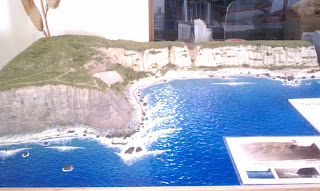The Dana Point Headlands is a small mini-museum at the tip of Dana Point. Inside it has cool, historical knick-knacks with explanations about the history of Dana. It explains what you will find on the nature walk it has for you along the hill. The Dana Point Headlands open space areas encompass approximately 60 acres and are comprised of areas by Harbor Point Park, Hilltop Park, Switchback Trail, and the Dana Point Reserve. Personally, I found their timeline interesting. In fact 1542 was the first time the Headlands Promontory was ever referenced a ship’s log. In 1776, the Mission was founded and The headlands became part of the Mission land. Richard Henry Dana first visited California and the cliffs of San Juan in 1834. The Church was ordered to give up the mission lands by Mexican government including Dana Point in 1835. Abraham Lincoln returned the mission lands to the Church and Dana Point was homesteaded by US Government in 1864. Dana Point became a famous place for people to start living in. The Headlands main goal is to protect the land and what remains, mainly plants. Dana Point provides examples of native southern wilderness and many plant communities. It includes 105 native plant species, eight of which are on the California Native Plant Society rare plant inventory. It also has 109 animal species, two of which are on the US fish and wildlife threatened and endangered list. A main part of the Headlands is the Central for Natural Lands Management, a non-profit organization that manages more than 60 natural areas in California. It conducts biological monitoring and maintenance activities and works with the City of Dana Point to ensure that the public enjoys the trails while understanding the importance of conserving rare habitat. While there, I saw two models of the coastline made by kids from San Clemente High School which I though was really cool because they were kind of like when we made the model coast out of sand. They had many abalone shells, dried sea urchins, and sea stars. I liked seeing those after having learned about them in class. My favorite part was this boat in the middle. It was made by high school kids and all their names were signed on it. One day they put it out on the water with a GPS so they could monitor where it went. Then they went back out and got it and but it in the interpretive center. I really like the Interpretive Center because it was small and it wasn’t overwhelming so I could just read and not have to spend an entire day there.
JSerraMARINEBIO12P6
Saturday, March 24, 2012
Friday, March 23, 2012
Sea turtle
The most interesting thing about this article in my view is that the sea turtle continues to surprise scientists with new information even today with the technology that we have. The fact that baby sea turtles travel thousands of miles as babies shows years and years of survival techniques that have been passed down generations to sustain the turtle population.
Monday, March 5, 2012
Sea Turtle Migration
Read about the new discovery in Sea Turtle migration. Post a paragraph about the article.
LINK: SEA TURTLE ARTICLE
LINK: SEA TURTLE ARTICLE
Thursday, March 1, 2012
Wednesday, February 29, 2012
Doheny
February 28, 2012, 5:00 P.M.
Air temperature: 57 degrees
Water temperature: 58 degrees
Weather Conditions: Clear skies
Ocean Conditions: choppy
Swell: Flat
Current: West
Tide: going from high to low tide
Animal Interaction: A lot of seagulls in the water, no surfers, a few people playing volleyball
Friday, February 24, 2012
First Woman Cicumnavigator
FIRST WOMAN TO CIRCUMNAVIGATE THE GLOBE!
Please read this article and give your thoughts about this individual and the events of her adventure.
Please click the title above:
Please read this article and give your thoughts about this individual and the events of her adventure.
Please click the title above:
Subscribe to:
Posts (Atom)













 Current: West
Current: West


